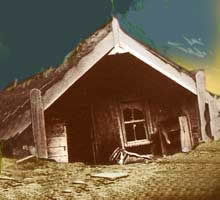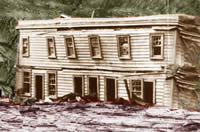
Dimdima
Online Children's Magazine from India

Dimdima
Online Children's Magazine from India

History alive today
Violent & unexpected, the eruption of the Tarawera volcano, during the early hours of June 10, 1886, was New Zealand's greatest natural disaster. For more than 4 terrifying hours, rocks, ash & boiling hot mud bombarded the peace of Te Wairoa village. About more than 150 people lost their lives & the eruption destroyed the pink & white terraces. The fiery glow in the night sky & the thunderous roar of the explosions were seen & heard far & wide. In the gloom of the day the wreckage of the hotels & houses, & the burial of 5000 square miles of scenic countryside brought awe & dismay to rescuers. 
Today you can see living history at Rotorua�s Buried Village, where nature displayed her most fierce & unforgiving forces.
A number of small dwellings remain undisturbed beneath the heavy mud & ash.
# The Blacksmith�s Shop : Inspect the tools & implements used to shoe the horses & maintain the coaches & wagons that brought visitors & supplies to this village
# Tohunga�s whare: In this house the Maori high priest who predicted the destruction remained buried for 100 hours. Reputedly aged 110 years, the man died several days later.
# Maori whare: This place was excavated to the original floor level. You can see the fireplace & some assorted relics recovered when digging first began in 1931.
# Flour Mill: You can see parts of the mill, including millstone & gears. Wheat was grown in the Te Wairoa Valley & the stream was diverted to drive the mill�s watermill.
# Aspen poplars: These are the tallest trees in New Zealand which grew from fence posts that formed a property boundary before the eruption. Tops of posts can be seen above the ground.
# Barman�s House: Some of the things found here were plates, household items, bottles, tools & implements, a well preserved fireplace & a cast iron bed frame.
# Stone Chimney: You can see the remains of the home of one of the two local Maori leaders.
# Faloona�s Store: One of two general stores in Te Wairoa, selling everything from tobacco to toothbrush.
# Rotomahana Hotel: This two storey wooden building collapsed six hours after the eruption. You can see some parts of the hotel.
# Baker�s oven: Bread was baked in this large unit from locally produced flour. It was built of hewn volcanic stone & imported firebricks.
# Stone storehouse: The people stored various foods for winter in this storehouse. You can view the Maori carvings in this type of a storehouse.

As you enter the gates of this Buried Village, you can take an emotional journey through the museum which tells the fascinating story of Te Wairoa village , the voyages to the Pink & White Terraces & the eruption of Mount Tarawera. You can also see the artifacts & belongings recovered from the village. You can wander in the scenic pathways that link the excavated sites & enjoy native bush & the Te Wairoa stream full of Rainbow trouts.
Dimdima is the Sanskrit word for ‘drumbeat’. In olden days, victory in battle was heralded by the beat of drums or any important news to be conveyed to the people used to be accompanied with drumbeats.
Bharatiya Vidya Bhavan
K. M Munshi Marg,
Chowpatty, Mumbai - 400 007
email : editor@dimdima.com
Bharatiya Vidya Bhavan
505, Sane Guruji Marg,
Tardeo, Mumbai - 400 034
email : promo@dimdima.com
Dimdima.com, the Children's Website of Bharatiya Vidya Bhavan launched in 2000 and came out with a Printed version of Dimdima Magazine in 2004. At present the Printed Version have more than 35,000 subscribers from India and Abroad.